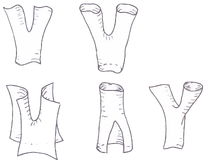| String Theory | ||
|---|---|---|

| ||
| All Roads Lead to String Theory (Polchinski) | ||
Prior to the First Superstring Revolution
| ||
| Early History | S-Matrix Theory Regge Trajectory | |
| Bosonic String Theory | Worldsheet String Bosonic String Theory String Perturbation Theory Tachyon Condensation | |
| Supersymmetric Revolution | Supersymmetry RNS Formalism GS Formalism BPS | |
Superstring Revolutions
|
||
| First Superstring Revolution | GSO Projection Type II String Theory Type IIB String Theory Type IIA String Theory Type I String Theory Type H String Theory Type HO String Theory Type HE String Theory |
|
| Second Superstring Revolution | T-Duality D-Brane S-Duality Horava-Witten String Theory M-Theory Holographic Principle N=4 Super-Yang-Mills Theory AdS CFT BFSS Matrix Theory Matrix String Theory (2,0) Theory Twistor String Theory F-Theory String Field Theory Pure Spinor Formalism |
|
After the Revolutions
| ||
| Phenomenology | String Theory Landscape Minimal Supersymmetric Standard Model String Phenomenology | |
|
This article is or was once a featured article on the Mathematics and Physics Wiki, which generally indicates a relatively well-written, or interesting article. |
String Perturbation Theory (or Perturbative String Theory) is a method for calculating the S-Matrix of a String Theory vacuum - the asymptotic scattering behavior of weakly coupled strings moving on that geometric background - as a sum over string histories of different topologies, analogous to the sum over Feynman diagrams employed in perturbative quantum field theory.
Also as in QFT, these scattering amplitudes only describe transitions from a state in the distant past to a state in the distant future. For the finite-time evolution of strings, one needs a more advanced formalism like String Field Theory.
Basics[]
Schematically, the scattering amplitude to start with strings in a state and to finish with strings in a state is[1]
where stands for a Measure on the Moduli Space of a particular topological class of Riemann Surfaces, is the action of a particular history from that class, and is a set of Vertex Operators encoding the initial state or final state .


![{\displaystyle \langle b|S|a\rangle =\sum _{\mathrm {topology} }\int {\mathcal {D}}X{\mbox{ }}e^{-S[X]}O_{a}[X]O_{b}[X]}](https://services.fandom.com/mathoid-facade/v1/media/math/render/svg/8f941b145f0cc6fafb7a0218e86193ae1953fee3)

![{\displaystyle S[X]}](https://services.fandom.com/mathoid-facade/v1/media/math/render/svg/c4cf30d35dedafcfdd1c57aab7daad50a10a1090)
![{\displaystyle O[X]}](https://services.fandom.com/mathoid-facade/v1/media/math/render/svg/00f46922e21cbd360b98e1e7e87a2d7e8abe7362)